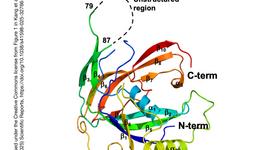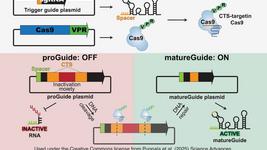Carbon
CARBON Newsletter (25 February 2025) - Your Latest News About CRISPR in AgroBio
By: Gorm Palmgren - Feb. 25, 2025
CRISPR AgroBio News (CARBON) - an emerging initiative from CRISPR Medicine News - has been hibernating for two years, but now we are back on track again.
CARBON will bring you the latest news on how CRISPR can shape agriculture for the future to guarantee food security in times of population growth and climate change.
To get more CRISPR AgroBio News delivered to your inbox, sign up to the free weekly CARBON Newsletter here.
Top picks
- The TwinPE prime editing-strategy, which uses two pegRNAs with complementary RTTs on opposite DNA strands, improved prime editing efficiency to 44.2% in rice, significantly outperforming single prime editing. This approach successfully restored rc gene function by inserting a missing 14-bp sequence, converting white grains to brown while maintaining stable inheritance and increased OsRc expression, though proanthocyanidin accumulation remained incomplete.
- Corteva and Gates Ag One have initiated a collaboration to accelerate gene-editing innovations for smallholder farmers. Using Corteva’s expertise in CRISPR-Cas and biotechnology, the partnership aims to enhance nutrient symbiosis in crops, improving productivity and climate resilience. This initiative targets sustainable yield increases, particularly in sub-Saharan Africa and South Asia, where climate change threatens crop output by up to 35% by 2050.
Technical advances
- CRISPR-Cas9 achieved nearly 100% editing efficiency in Liriodendron tulipifera using a single-cell-derived somatic embryogenesis system. Compared to CRISPR-Cpf1, Cas9 was more effective for PDS gene knock-out, yielding 137 regenerated plantlets, 82.48% of which were albino. Homozygous mutations were confirmed via sequencing. This approach enables both functional genomics and scalable propagation of genome-edited tulip trees.
- FAST-PB is a high-throughput, automated pipeline for CRISPR-based plant bioengineering in maise and Nicotiana benthamiana. It integrates biofoundry engineering, protoplast transfection, and MALDI-MS for single-cell lipid profiling. Using CRISPR activation, lipid production increased sixfold, and an automated transformation platform regenerated edited plants. This system accelerates genome editing, metabolic engineering, and synthetic biology in plants.
- CRISPR-Cas knock-in of miRNA target sequences into the 3′ UTR enables precise spatiotemporal gene suppression in rice. Using GID1, mediating gibberellin (GA) perception, as a test case, miR156a induced a 97% constitutive reduction, miR396c limited suppression to shoots, and miR528 triggered light-dependent knockdown. This miRNA-mediated in-locus knockdown (MiRKD) offers a powerful tool for conditional gene regulation in crop breeding.
- Chinese researchers at Qi Biodesign have developed v2_TMV/DEN2, an optimised mRNA delivery system for CRISPR-Cas editing in plants, enhancing transgene-free genome editing efficiency. By refining 5′UTRs (including DEN2 from dengue virus), poly(A) tails, and using protamine coating, editing rates improved 4.7-fold for knock-outs and 3.4- to 2.5-fold for base editing in rice and wheat. This approach significantly outperforms plasmid-based methods, offering a more effective tool for crop improvement.
- CRISPR-Act3.0 enhances plant gene activation by integrating SunTag peptides with MS2-coat proteins, improving efficiency over CRISPR-Act2.0. This system expands targetable sequences by incorporating Cas12b for T-rich PAMs and SpRY dCas9 for near PAM-free targeting. Its advanced design enables multiplexed gene activation, overcoming previous limitations in plant biotechnology and offering new precision tools for crop improvement.
- CRISPR-Cas9 multiplex editing in alfalfa was enhanced using endogenous MsU6 promoters and a polycistronic tRNA-sgRNA system. This optimised system enabled the simultaneous editing of three or four genes with visual selection via RH1 or RUBY reporters. Stable transformation produced red-coloured shoots, improving efficiency in functional genomics and alfalfa breeding.
- CRISPR-Cas9 was used to induce chromosomal inversions in Arabidopsis thaliana, relocating pericentromeric heterochromatin into euchromatic regions. Whole-genome bisulfite sequencing and chromatin immunoprecipitation revealed minimal impact on global epigenetic patterns, with inverted regions retaining their original histone marks and DNA methylation. Transcriptome analysis showed limited gene expression changes, suggesting chromosomal position has little effect on epigenetic stability.
- Chinese researchers present T-SAFE, a CRISPR-Cas9-based system for transgene self-elimination in plants, enabling marker-free genome modification. Using spacer sequences from Drosophila’s Ebony gene, T-SAFE removes selection markers post-integration with 10–30% efficiency in Arabidopsis and 5–8% in rice. A reproductive cell-specific Cas9 promoter prevents unintended cleavage, offering a safer approach to plant genetic engineering.
- A novel CRISPR-Cas9 cytosine base editor using SsdA, a DYW-like deaminase, enables efficient C-to-T editing. A G103S mutation enhances activity while reducing toxicity, and truncations create an exceptionally small enzyme. The SsdA-base editor induces mutations in rice, barley, and mammalian cells, demonstrating its potential as a compact and efficient genome editing tool.
- CRISPR-Cas9 editing of eight RR-TZF genes in Oryza sativa (Nipponbare) achieved 73.8% efficiency, primarily inducing short indels near PAM sites. Off-target effects were detected at 5 of 31 predicted sites but may be minimised with optimised gRNA design. Inheritable mutations emerged in progeny, complicating phenotypic outcomes. These findings highlight the need for backcrossing to refine rice trait evaluation.
- A deconstructed wheat dwarf virus (dWDV)-based delivery system enhanced CRISPR-Cas9-mediated homology-directed repair (HDR) in rice, achieving 10% efficiency. This method enabled precise amino acid substitutions in OsEPSPS without yield penalties. Sanger sequencing confirmed targeted edits. The approach simplifies HDR into a two-component system, demonstrating the potential of viral replicons for efficient genome modification in crops.
Disease and stress control
- CRISPR-Cas knock-out of SlABCG45 in tomato enhances resistance to parasitic weedsPhelipanche and Orobanche by reducing strigolactone exudation, a key trigger for parasite germination. Despite increased resistance, yield remained stable in parasite-free fields and improved by ~30% in infested conditions.
- CRISPR-dCas9-TV transcriptional activation enhanced the expression of PvD1, Pv-thionin, and Pv-lectin in Phaseolus vulgaris hairy roots, with upregulation ranging from 1.37- to 6.97-fold. No off-target effects were detected, confirming precision. This proof-of-concept study demonstrates the potential of CRISPR-based gene modulation for improving disease resistance in common beans.
- CRISPR-based editing of eEF1Bγ genes in Nicotiana benthamiana reduced Tobacco etch virus accumulation, suggesting its role as a viral host factor. Using virus-induced gene editing, plants with three of four eEF1Bγ homologs knocked out showed no resistance to PVX, TMV, or TBSV. These findings highlight the potential of targeting diverse host factors for engineering durable virus resistance in plants.
- CRISPR-Cas9 knock-out of SlHP2 and SlHP3 in tomatoes improved drought tolerance by enhancing water retention, reducing stomatal density, and promoting deeper root growth. Edited lines exhibited lower oxidative damage and downregulated cytokinin signalling and stomatal differentiation genes under stress. These findings highlight the potential of targeting cytokinin pathways for improving drought resilience in crops.
Agronomic traits
- CRISPR-Cas editing of UCL23 in rice modulates cadmium (Cd) absorption and accumulation by regulating reactive oxygen signalling. WRKY51 represses miR528, which targets UCL23, creating a dual-modulatory control over Cd uptake. Natural UCL23 haplotype variations influence Cd accumulation, with Japonica-type alleles reducing Cd levels in Indica rice. This study provides key insights for breeding low-Cd rice to enhance food safety.
- CRISPR-Cas9 knock-out of ZmPMT1 in maise disrupts p-coumaroylation of lignin, enriching guaiacyl lignin without reducing total lignin content. This modification enhances lignin oil quality for bio-based polyurethane production while maintaining maise’s value as food and feed. The engineered biomass supports sustainability by offering a renewable alternative to fossil-derived chemicals, aligning with circular bioeconomy goals.
- CRISPR-Cas-mediated knock-out of BnaA09.MYB52 in Brassica napus reduces seed coat content by up to 8.2% and increases seed oil content by up to 13.4%. BnaA09.MYB52, predominantly active in the seed coat, regulates PMEI14 and BAN, linking thinner seed coats with higher oil accumulation—a promising target for improving crop oil yields.
- CRISPR-Cas editing of Coq1 in rice and wheat enabled the production of Coenzyme Q10 (CoQ10) instead of CoQ9 by altering key amino acids in the enzyme’s catalytic pocket. These modifications mimic natural evolutionary changes that independently drove CoQ9 synthesis in angiosperms. The findings offer a strategy to biofortify staple crops with CoQ10, enhancing their nutritional value for human health.
- CRISPR-Cas knock-out of SHATTERING ABORTION3 (SHAT3) in rice reduces seed shattering by increasing pedicel tensile strength and disrupting abscission zone separation. SHAT3 regulates jasmonic acid accumulation, essential for cell wall hydrolysis during seed detachment. Mutants showed significantly lower shattering rates, offering a genetic target for reducing grain loss in rice cultivation.
- CRISPR-Cas knock-out of GhMML3_D12 in cotton disrupts fuzz fibre development, while dual knock-out of GhMML3_A12 and GhMML3_D12 leads to a fiberless phenotype. Overexpression restores fibre growth, confirming GhMML3’s role in fibre initiation. Transcriptome and single-cell RNA-seq analyses identify GhMML3 as a hub gene regulating fibre development, directly activating GhHD-1 and GhMYB25.
- CRISPR-Cas9 knock-outs of Chlamydomonas CrCTI1, a negative regulator of acetyl-CoA carboxylase (ACCase), enhanced fatty acid accumulation by 25% and increased triacylglycerol (TAG) storage up to fivefold. Phosphomimetic mutations disrupted CrCTI1–ACCase interactions, linking phosphorylation to lipid metabolism regulation. These findings highlight CrCTI1 as a target for engineering high-lipid microalgae for biotechnology applications.
- CRISPR-Cas9 knock-out of GmAOC4H8 in soybean enhanced seed germination, indicating its role as a negative regulator. Mutants showed reduced jasmonic acid levels and altered expression of JA-related genes. GmAOC4 was subject to selection during domestication, with lower frequencies of the repressive GmAOC4H8 variant in cultivated soybeans.
Industry
- Cibus has retracted its previously reported 10–25% CRISPR-Cas gene editing conversion rates in rice, citing high variability in subsequent experiments. The company continues refining its oligonucleotide-directed mutagenesis (ODM) approach to enhance editing efficiency. Despite inconsistencies, Cibus remains confident in its Rapid Trait Development System™ for delivering predictable gene edits in commercial crops like rice, canola, and soybean.
- Corteva reported strong Q4 2024 results, driven by record crop demand and disciplined execution. Net sales rose 7% to $4.0B, with a 13% organic sales increase. Operating EBITDA grew 36% to $525M. Full-year 2024 net sales declined 2% to $16.9B, but organic sales rose 1%. For 2025, Corteva expects net sales of $17.2–$17.6B and operating EPS of $2.70–$2.95.
Detection
- South African researchers have used a combination of CRISPR-Cas12a and recombinase polymerase amplification (RPA) to develop a rapid, isothermal detection assay for Fusarium oxysporum f. sp. cubense tropical race 4 (Foc TR4). The assay demonstrated high sensitivity (10 fg target DNA) and specificity, successfully identifying Foc TR4 in field samples. Visual detection under LED blue light enables cost-effective, in-field diagnostics to aid containment efforts.
Screening
- A systematic screen of 66 cytidine deaminases identified new CRISPR-Cas cytosine base editors (CBEs) with high efficiency, broad editing windows, and minimal off-target effects in rice. The Orcinus orca-derived OoA3GX2 exhibited robust activity across diverse sequence contexts, enabling precise C-to-T editing. These findings expand the CBE toolkit for advanced plant genome engineering.
Reviews
- Transforming tomatoes into GABA-rich functional foods through genome editing: A modern biotechnological approach. This review highlights the significance of GABA-boosted functional foods and explores the potential of CRISPR-Cas9 technology for developing GABA-enriched tomatoes.
- CRISPR/Cas genome editing for cotton precision breeding: mechanisms, advances, and prospects. This review discusses the advancements, applications, and challenges of CRISPR-Cas genome editing in cotton. It highlights its potential to improve fibre yield, quality, stress resistance, and other agronomic traits while addressing the complexities of editing its tetraploid genome.
- The future of rubber production: a review of genetic regulation of biosynthetic pathways and genome editing technologies in natural rubber-producing plants. This review examines the application of genome editing, particularly CRISPR-Cas9, to enhance rubber quantity, quality, disease resistance, and growth in rubber-producing plants, discussing recent advances, challenges, and future prospects for the rubber industry.
- Enhancing tiny millets through genome editing: current status and future prospects. This review explores the potential of CRISPR-Cas9 in improving small millets by enhancing resistance to biotic and abiotic stresses, addressing breeding challenges, and proposing strategies to develop stress-resistant, nutrient-rich cultivars for sustainable agriculture.
- Advances in lignocellulosic feedstocks for bioenergy and bioproducts. This review examines current efforts and future opportunities for leveraging lignocellulosic feedstocks in bio-based energy and products, with a focus on enhancing conversion efficiency and scalability.
- Advancing vegetable genetics with gene editing: a pathway to food security and nutritional resilience in climate-shifted environments. This review examines recent advances in CRISPR-Cas9 gene editing for improving vegetable resilience to climate stress, enhancing nutritional content, and increasing agricultural productivity while also discussing regulatory, ethical, and public acceptance challenges.
- Genome editing, an opportunity to revive soybean cultivation in Europe. This review explores the potential of CRISPR-Cas genome editing to accelerate soybean breeding in Europe, enhancing traits like stress resilience, yield, and quality to support sustainable agriculture and reduce import dependence.
- Nanodelivery of nucleic acids for plant genetic engineering. This review explores nanoparticle-mediated DNA and RNA delivery systems for plant genetic engineering, highlighting recent advances, challenges, and the potential of plant-derived exosome-like nanoparticles for CRISPR-Cas9 delivery.
Tags
CLINICAL TRIALS
IND Enabling
Phase I
Phase II
Phase III
Gastric Cancer and Colorectal Cancer, CRC, (NCT07166263)
Sponsors:
Base Therapeutics (Shanghai) Co., Ltd.
Sponsors:
Base Therapeutics (Shanghai) Co., Ltd.
IND Enabling
Phase I
Phase II
Phase III
Relapsed or Refractory Acute Myeloid Leukemia, AML, (NCT06541444)
Sponsors:
Base Therapeutics (Shanghai) Co., Ltd.
Sponsors:
Base Therapeutics (Shanghai) Co., Ltd.
IND Enabling
Phase I
Phase II
Phase III







